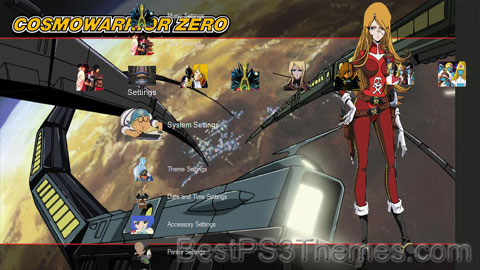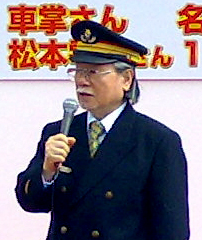Leiji Matsumoto theme by TOUGY
Download: LeijiMatsumoto.p3t

(5 backgrounds)
Leiji Matsumoto | |
|---|---|
松本零士 | |
 Matsumoto signing books in 2014 | |
| Born | Akira Matsumoto January 25, 1938 Kurume, Fukuoka, Empire of Japan |
| Died | February 13, 2023 (aged 85) Tokyo, Japan |
| Known for | Character design, illustration |
| Notable work | |
| Spouse | Miyako Maki |
| Awards | |
| Website | leiji-matsumoto |
| Part of a series on |
| Anime and manga |
|---|
 |
|
|
Leiji Matsumoto (Japanese: 松本零士, Hepburn: Matsumoto Reiji, born Akira Matsumoto (松本晟); January 25, 1938 – February 13, 2023) was a Japanese manga artist, and creator of several anime and manga series. His widow Miyako Maki is also a manga artist.[3]
Matsumoto was famous for his space operas such as Space Battleship Yamato and Galaxy Express 999.[4] His style was characterized by mythological and often tragic storylines with strong moral themes, noble heroes, feminine heroines, and a love of strange worlds and melancholic atmosphere.[5]
Early life[edit]
Leiji Matsumoto was born on January 25, 1938, in Kurume, Fukuoka.[6] He was the middle child of a family of seven brothers, and, in his early childhood, Matsumoto was given a 35mm film projector by his father, and watched American cartoons during the Pacific War. During this time, he gained an interest in science fiction novels by authors Unno Juza and H. G. Wells.[7] Matsumoto started drawing at the age of six, and began drawing manga three years later after seeing the works of Osamu Tezuka.[6] At 18, he moved to Tokyo to become a manga artist.[7]
Career[edit]

In 1954, Matsumoto made his debut under his real name, Akira Matsumoto, with Mitsubachi no bōken in the magazine Manga Shōnen.[8]
Matsumoto's big break came with Otoko Oidon, a series that chronicled the life of a rōnin (a young man preparing for university entrance exams), in 1971. In 1972 he created the mature-themed dark comedy Western seinen series Gun Frontier for the Play Comic magazine, which ran from 1972 to 1975. Around the same time he started a series of unconnected short stories set during World War II, Senjo Manga Series, which would eventually become popular under the title The Cockpit.[5]
He was involved in Space Battleship Yamato (1974) and created the highly popular series Space Pirate Captain Harlock (1977) and Galaxy Express 999 (1977). In 1978, he was awarded the Shogakukan Manga Award for shōnen for Galaxy Express 999 and Senjo Manga Series.[9] Animated versions of Captain Harlock and Galaxy Express 999 are set in the same universe, which spawned several spin offs and related series, most notably Queen Emeraldas and Queen Millennia.[5]
Matsumoto supervised the creation of several music videos for the French house group Daft Punk, set to tracks from their album Discovery. These videos were issued end-to-end (making a full-length animated movie) on a DVD release titled Interstella 5555: The 5tory of the 5ecret 5tar 5ystem.[5]
Approximately two dozen bronze statues – each four feet tall – of characters and scenes from Space Battleship Yamato and Galaxy Express 999 were erected in the downtown area of Tsuruga in 1999. Each statue includes a plaque at its base explaining the character and features Matsumoto's signature.[10]

Matsumoto worked with Yoshinobu Nishizaki on Space Battleship Yamato (known outside Japan under various names, but most commonly as Star Blazers).[11][12] Matsumoto created a manga loosely based on the series, and the Yamato makes cameo appearances (sans crew) in several of his works including the Galaxy Express 999 manga.[5]
A later work by Matsumoto called Great Yamato featuring an updated Yamato was renamed Great Galaxy due to legal issues with Nishizaki.[13][14][15][16] As of 2009, Matsumoto and Nishizaki were working on independent anime projects featuring the acclaimed Space Battleship Yamato, with the conditions that Matsumoto cannot use the name Yamato or the plot or characters from the original, and Nishizaki cannot use the conceptual art, character or ship designs of the original.[17]
In August 2014, to celebrate the 60th anniversary of his debut, Matsumoto launched the manga Captain Harlock: Jigen Kōkai (Captain Harlock: Dimensional Voyage), illustrated by Kōichi Shimahoshi, in the pages of Akita Shoten's Champion Red magazine.[18] Dimensional Voyage is a retelling of the original 1978 Space Pirate Captain Harlock manga. It had been licensed in the United States by Seven Seas Entertainment.[19]
Personal life[edit]
Matsumoto was married to manga artist and Licca-chan creator Miyako Maki.[20]
On November 15, 2019, Matsumoto suffered severe respiratory problems and collapsed during an event in Turin, Italy, for the 40th-anniversary tour celebrating the Captain Harlock anime adaptation. He was taken to a hospital in critical condition and had a breathing tube inserted after he was admitted to the emergency unit.[21] However, he was considered to be out of danger two days later.[22]
Death[edit]
Matsumoto died of acute heart failure at a hospital in Tokyo on February 13, 2023, at the age of 85.[20] Various manga artists offered condolences, including Yasuhiro Nightow, Nozomu Tamaki, and his wife Maki. Galaxy Express 999 voice actress Masako Nozawa and translator Zack Davisson also gave their condolences.[23]
Selected works[edit]
See also[edit]
- Marianne Hold—German actress who is the template for Matsumoto's lead female characters.[26]
References[edit]
- ^ "Leiji Matsumoto, Shigeru Mizuki Earn Government Honors". Anime News Network. Retrieved October 21, 2013.
- ^ "Celebrated Manga Author Leiji Matsumoto Honored With Prestigious Ordre des Arts et des Lettres At The Rank Of Knight" (Press release). Anime News Network. Retrieved October 21, 2013.
- ^ "牧美也子のプロフィール". allcinema. July 29, 1935. Retrieved October 21, 2013.
- ^ Yamaguchi, Maria (February 20, 2023). "Leiji Matsumoto, creator of 'Space Battleship Yamato,' dies". ABC News. Retrieved February 20, 2023.
- ^ a b c d e f g h i j k l m n o p q r s t u v w x y z aa ab ac ad ae af Toole, Michael (June 3, 2012). "The Mike Toole Show: A Leijiverse of Possibilities". Anime News Network. Retrieved February 21, 2023.
- ^ a b 松本零士が85歳で死去、零時社・松本摩紀子氏「星の海に旅立ちました」. Natalie (in Japanese). February 20, 2023. Retrieved February 21, 2023.
- ^ a b Tatsumi, Mook (2005). The World of Leiji Matsumoto.
- ^
